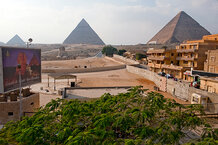 |
 Thermal
scans revealed an anomaly in the ancient walls of the pyramid. While
much of the wall uniformly heats up and cools down each day, a spot on
the eastern side of the structure behaves differently. There was a six
degree Celsius (11 F.) difference in temperature compared with
surrounding stones.
Thermal
scans revealed an anomaly in the ancient walls of the pyramid. While
much of the wall uniformly heats up and cools down each day, a spot on
the eastern side of the structure behaves differently. There was a six
degree Celsius (11 F.) difference in temperature compared with
surrounding stones.That distinct heat signature could mean some passage, room or other insight is hidden in or behind that wall.
Recommended: Are you scientifically literate? Take our quiz
"This anomaly is really quite impressive and it’s just in front
of us, at the ground level," Mehdi Tayoubi, founder of the organization
that is conducting the pyramid thermal scanning experiments, told the Huffington Post. But he is hesitant to share potential explanations.There may be a chamber or passage revealed behind the wall, but any explanation could reveal a lot about the ancient Egyptians that built the pyramid.
"At the very least, this anomaly will shed additional light on the construction techniques of the 4th dynasty Egyptians," egyptologist Beth Ann Judas told the Huffington Post. "It's rather exciting actually. Over the past few years, archaeologists have been learning more about the workmen and officials who are connected to the pyramids, and this gives us more information about their work."
Already, it’s not surprising that the thermal anomaly was found on the eastern side of the Great Pyramid, says Dr. Judas. The east side would have been the front of the pyramid, as almost everyone coming to the structure would have approached from the Nile, to the east. Furthermore, the sun rises in the east and ancient Egyptian religion revered the sun god Ra.
This thermal anomaly was discovered as part of the Scan Pyramids project, organized by the Paris-based Heritage Innovation Preservation Institute. The researchers conducted thermal scans of the pyramid at various intervals, particularly focusing on the mornings and evenings.
As the stones heat up in the morning, and cool down in the late afternoons, they should do so uniformly if they are made of the same material. But if there are different materials – or cavities in the structure – some parts of the pyramid will heat up or cool down faster than others.
When the Scan the Pyramids project is over, the researchers will have scanned the Great Pyramid, also known as Khufu or Cheops, Khafre or Chephren also at Giza, the Bent pyramid and the Red pyramid at Dahshur. The scientists are also employing techniques such as muon radiography imaging, 3D scans, and topographical scans via drones.
Already the project has tackled some exciting questions. Archeologists discovered an anomaly in the northern wall of King Tut’s tomb thought to be another chamber. If that’s the case, the sarcophagus of an ancient queen might be buried there.
But the Scan the Pyramids project scientists are simply looking for anomalies that might suggest something to the archeologists. They hope their scans will produce concrete results that the egyptologists can investigate.
As the project's website begins the about page, "Just because a mystery is 4500 years old doesn’t mean it can’t be solved…" see more




No comments: